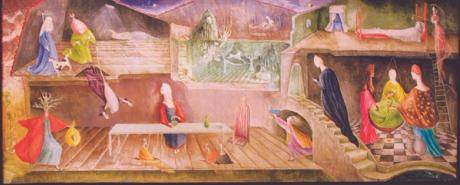
Hyenas, horses and bats come together through the paintings and stories of Leonora Carrington (1917-2011), associated with revolt, freedom and fear. The precision of its details – in a style of painting originally developed from the Florentine Quattrocento – could put the macabre at the service of subversion. As she found her creative force, her growing commitment to feminism coincided with her exploration of esoteric and unconventional belief systems.
In the form of an illustrated biography, Surreal spaces is underlined by the author’s family connection to his subject: Carrington was the daughter of Joanna Moorhead’s great-aunt. The codes of Edwardian England, anachronistically blending foxhunting and the ambitious marriage market, could not contain Carrington’s demand to create his own world. At the age of 20, the call of painting and surrealism combined in an idyllic moment of connection with Max Ernst – with whom she entered into a scandalous relationship, despite being married – before the World War II breaks out and Carrington sinks into tortured incarceration in a Spanish asylum, eventually escaping via Lisbon to New York and Mexico.
Moorhead energetically tells this now familiar story. She vividly recounts the improbable survival of the Alliberts, the house that Carrington bought and shared with Ernst in Saint-Martin d’Ardèche, which has remained almost unchanged since she had to abandon it in 1940, even to the point of retaining the artist murals. , his books on the library and his letters on the desk.
Moorhead has already extracted this material for his previous book, The surreal life of Leonora Carrington (Virago 2017), and while the story is certainly worth telling, this revisit is rather glossed over in Surreal spaces. Those who have read the previous book will be familiar with the narrative voice and will find specific phrasing echoes. While unsurprising, this duplication raises questions about the relationship between the publications. As this is only directly addressed once (when the identification of the house Carrington occupied in Lisbon is changed), it is up to the reader to decide whether the new research acts as a fix or an augmentation. As Surreal spaces offers a wealth of new information but does not claim to be a historical account of scholarly art, it is simply enticing and, as any account of Carrington’s life is worthwhile, should perhaps encourage enthusiasts to read the two.
What the new book brings, as the title suggests, is a more detailed account of the locations of Carrington’s life and production, from the Dawn Horse Inn (the title of his 1937-38 self-portrait) at 194 Calle Chihuahua, his longtime home in Mexico City (recently opened as a house-museum). Moorhead traced every step of her cousin’s multiple migrations. In the early chapters, family backgrounds are explored and familiar paintings are linked to Carrington’s childhood homes, in particular the Alfred Waterhouse-designed Crookhey Hall (near Lancaster) from his early years.
Clearly it is in the moments of rebellion that Moorhead finds the greatest wealth: the chapter on the summer of 1937 with Ernst and other Surrealists hiding in Cornwall from Carrington’s vengeful father accounts for almost half of that spanning 26 years in Mexico. This seems to reflect the plunge into distant memory that Carrington shared with Moorhead during their biannual encounters over the last five years of the artist’s long life.
Carrington has resisted theorizing around his works, so that although several art historians and literary scholars are quoted (Susan Aberth, Whitney Chadwick, Gloria Orenstein, Penelope Rosemont), there is a preference for answers rather than for analysis. It’s a bit of a paradox, because it was precisely these scholars (and many others) who, for more than 40 years or so, helped restore Carrington’s work to the position it long deserved. Substantial publications include Leonora Carrington and the international avant-garde (Manchester University Press 2017)—with contributions from the artist’s son, Gabriel Weisz Carrington—and accompanying catalog Leonora Carrington: Revelationcurated by Tere Arcq and Carlos Martin and currently presented at Fundación MAPFE in Madrid (until May 7).
There is a welcome profusion of illustrations in Surreal spaces this alone justifies revisiting the material. Several paintings, however, are illustrated but not mentioned, and, more frustratingly, some are discussed but not illustrated. Given the need to guard against Carrington being typecast as Ernst’s muse, it seems unfortunate to reproduce two of her illustrations for her book. The House of Fear rather than his painting Lord’s Supper candlestick (1938). The Mexican chapter would have benefited from examples of the work of Remedios Varo and Kati Horna (which Moorhead included in the 2010 exhibition she curated with Tere Arcq and Stefan van Raay, surreal friends at the Pallant House Gallery, Chichester). and imagination.
• Matthew Gale is an independent art historian and curator
• Joanna Moorhead, Surreal Spaces: The Life and Art of Leonora Carrington, Thames & Hudson, 256pp, 80 illustrations, £30 (hb), published June 1
